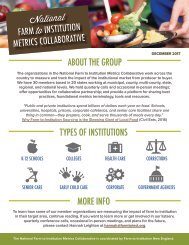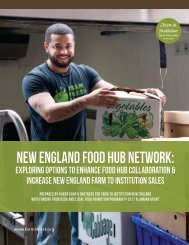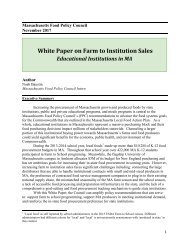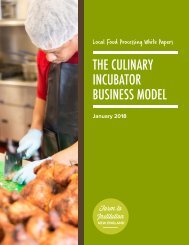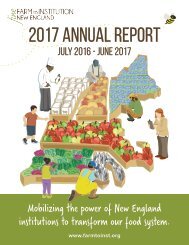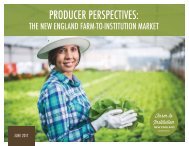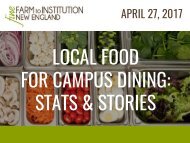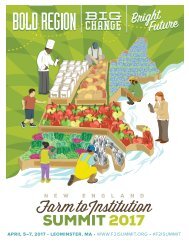FINE Workforce Dev White Paper
Create successful ePaper yourself
Turn your PDF publications into a flip-book with our unique Google optimized e-Paper software.
SUMMARY<br />
The demand for local food is strong and growing. Strengthening local/regional food systems has<br />
the potential to spur economic development, but a culinary workforce equipped with greater skills is<br />
necessary to make the transition. Demographic trends, cultural messaging, and past policy choices<br />
have resulted in an aging manufacturing workforce and a limited pipeline of new talent. Food<br />
manufacturers rely on increasingly sophisticated technology and food safety measures, meaning their<br />
workforce needs a higher degree of training than in the past. New food businesses, which may be<br />
less automated, often struggle to attract and retain staff due to intermittent production schedules and<br />
inconvenient locations. Industry wages significantly lower than in other sectors, the increasing cost of<br />
higher education, unclear pathways to advancement, and negative perceptions all discourage young<br />
people from pursuing a career in food manufacturing. Despite these many challenges, innovative<br />
programs are successfully using culinary skill-building to help even disadvantaged populations<br />
become valuable members of the food sector workforce. Pioneering companies have shown the<br />
competitive advantage in embracing a shift to greater local/regional sourcing and the mutual benefits<br />
of investing in workforce development. Leading educational institutions are developing the curricula<br />
to impart the skills and knowledge the next generation of food sector workers will need, as well as<br />
supporting training for existing industry members and the conception, creation, and launch of new food<br />
businesses. “Stackable credentials” are gaining traction as a mechanism to help close the skill gap in<br />
the current workforce and increase equity in access to postsecondary education. Federal policy, in the<br />
form of the <strong>Workforce</strong> Innovation and Opportunity Act, has mandated states work strategically with<br />
industry to address workforce development, and in states where a unified policy in support of the new<br />
food economy is in place, positive results are already becoming apparent.<br />
RECOMMENDATIONS<br />
Food Manufacturers<br />
• Invest to find the right employees and keep them. Turnover is expensive, and as training needs<br />
continue to expand the cost will only grow.<br />
• Create pathways to advancement. Communicate to employees how gaining the appropriate skills<br />
(food safety, process control, etc.) can support their growth at the company. Make employees aware<br />
of different credentialing opportunities (ServSafe, HACCP, SQF, ISO, etc.) and work with those<br />
interested to ensure they can access.<br />
• Build strategic partnerships. Support organizations can help employees navigate and address<br />
challenges outside of the workplace that may be impacting their performance. A small investment<br />
in finding and developing partnerships can reap substantial rewards in employee morale and<br />
reduced turnover.<br />
• Make innovative labor practices part of your brand. The Millennial generation (the 75 million<br />
born between 1981 and 1997; Fry) is now the single largest consumer demographic and more than<br />
75% are willing to pay a premium for sustainable brands, a measurement that includes the degree<br />
to which “a company is known for its commitment to social value” (Neilsen). Investing in human<br />
capital creation through workforce development can be both a cost-savings measure and a public<br />
relations benefit.<br />
WORKFORCE DEVELOPMENT: A CHALLENGING OPPORTUNITY<br />
11




